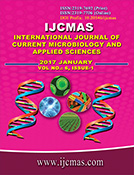


 National Academy of Agricultural Sciences (NAAS)
National Academy of Agricultural Sciences (NAAS)

|
PRINT ISSN : 2319-7692
Online ISSN : 2319-7706 Issues : 12 per year Publisher : Excellent Publishers Email : editorijcmas@gmail.com / submit@ijcmas.com Editor-in-chief: Dr.M.Prakash Index Copernicus ICV 2018: 95.39 NAAS RATING 2020: 5.38 |
An F2 population derived from a cross between a high salt-tolerance indica variety, TCCP266, and a susceptible elite temperate-japonica Egyptian variety, Sakha102, were produced. We performed QTL mapping for physiological traits related to rice salt-tolerance. Single plant analysis of each of the polymorphic marker was carried out using randomly selected 288 F2 individuals. 50 polymorphic markers covered four chromosomes of rice (1, 3, 4 and 9). A total of 24 QTL were detected (LOD score > 2.0), which were distributed on the four chromosomes. The number of QTL was detected in non-saline (14) and saline soil (10). Seven QTL for Na+ concentration were detected in leaves at vegetative stage and stem at reproductive stage, while no QTL were detected in stem at vegetative stage as well as leaves at reproductive stage with LOD score >2.0. These 7 QTL are localized on chromosomes 1, 3 and 4. Two QTL on chromosome 1, two on chromosome 4 and three in chromosome 3. A total of 13 QTL were detected (LOD score > 2.0) for K+ concentration on chromosomes 1, 3, 4 and 9. LOD score ranged from 2.09 to 4.54 and the phenotypic variance explained by a single QTL (R2) ranged between 5.3% and 12.7%. Four detected QTL controlling Na+/K+ ratio were distributed on two chromosomes 4 and 9 with LOD score range between 2.55 to 3.95 and a range of phenotypic variance explained between 7.4% up to 11.2%. The detection of new QTLs associated with salt tolerance will provide important information for the functional analysis of rice salt tolerance.
 |
 |
 |
 |
 |